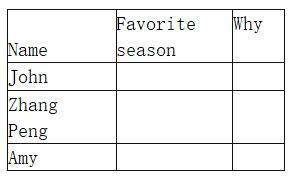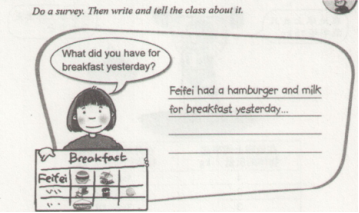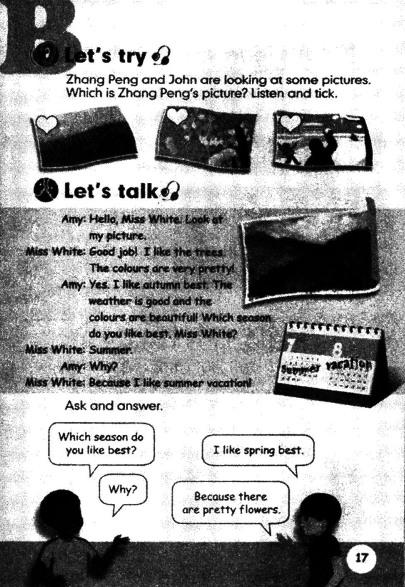(1)提高课堂活泼性的措施 ①创设轻松、愉快的课堂环境。良好的课堂气氛能使学生的思维处于良好的状态,从而有助于提高学生参与课堂的积极性。
②选择适宜、合理的教学方法。不同年龄的学生有不同的认知特点,要针对学生的具体情况,灵活使用多种教学方法。例如使用游戏教学法会提高小学生参与课堂的主动性。
③使用生动、恰当的教学语言。教师生动、有趣的课堂语言能弥补一些教学内容本身的枯燥,使学生得到意想不到的乐趣,从而有助于提高其参与课堂学习的热情。
④采用形象、直观的教学手段。采用实物、模型、多媒体等直观教学的手段,可以集中学生的注意力,唤起学生学习的兴趣,有利于提高课堂活泼性。
⑤设计丰富、有趣的教学活动。小学生活泼好动,利用丰富、有趣的活动可以寓学于乐,激发学生的主动性。
(2) Teaching Aims
Knowledge aims: ① Students can learn the new words:spring, summer, fall, winter.
② Students can master the sentence pattern: What is your favorite season
Ability aim: Through cooperation and discussion, students can describe their favorite season and their listeningand speaking ability can be improved.
Emotional aim: Students' love for nature can be aroused.
(3)导入和巩固环节
Warming up and lead-in(导入环节):
①Daily greeting
T:What’sthe weather like today
Ss:It’s cool/cold/hot/warm…
②Ask students how many months and seasons there are in a year to lead in the new topic.
【设计意图】
通过与本课主题相关的日常问题问答.来拉近与学生之间的距离并激活学生已有的背景知识,为新授环节做好铺垫。
Consolidation(巩固环节):
Activity 1 :Do a survey
Let students find out their partners' favorite season using the new sentence they have learned and ask reasons,and then finish the chart.

Activity 2:Draw a picture
According to their favorite season, each student should draw a picture and try to describe their pictures to others.
【设计意图】
通过小组调查和画画活动,能够增进学生之间彼此交流和了解,增强合作意识,并且能够巩固所学知识。






